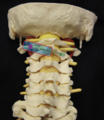Greater Occipital Nerve Injection
From WikiMSK
{{procedure
|indication=occipital neuralgia
|syringe=3mL
|needle=27-30G
|steroid=optional 40mg triamcinoloneCite error: Closing </ref> missing for <ref> tag
Indications
- Suspected or confirmed occipital neuralgia
- Migraine refractory to conservative treatment
- Post-lumbar puncture headache refractory to conservative treatment
- Cluster headache, occipital neuralgia, cervicogenic headache, or migraine with occipital nerve irritation or tenderness [1]
Contraindications
- Infection overlying injection site
Ultrasound Guided
Procedure
- In-plane technique
- Prone, side-lying, or seated position with the head slightly flexed.
- Stand contralateral to the injection site, in line with the transducer and with the ultrasound screen on the opposite side
- Using a high-frequency linear array transducer, localize the C2 spinous process which is bifid. The C1 spinous process is not bifid.
- Slide the probe laterally (away from yourself) towards the ipsilateral lamina of C2.
- Rotate the lateral part of the transducer cephalad until the transverse process of C1 is visualized (around 20–30 degrees).
- Identify the muscular tissue planes and the greater occipital nerve
- Colour doppler can be used to identify the occipital artery which lies next to the greater occipital nerve
- Insert the needle in-plane from medial to lateral and advance until the needle tip is close to the nerve.
Non-ultrasound Guided
- Patient in position of comfort allowing access to posterior head and neck. (laying prone or sitting with head down in arms)
- Identify Greater Occipital Nerve (GON).
- Cleanse skin with betadine or chlorhexidine and allow to dry
- Insert needle over nerve at 90 degrees to skin until hit bone, then withdraw slightly[4]
- If using ultrasound, insert needle at 45 degrees to skin and advance toward nerve under direct ultrasound guidance
- Aspirate to ensure not in vessel.
- Inject ~1-3 mL of local anesthetic. (may inject small amount medial and lateral to nerve to ensure adequate block)[5]
- Repeat on contralateral side, if indicated.
Maximum Doses of Anesthetic Agents
| Agent | Without Adrenaline | With Adrenaline | Duration | Notes |
| Lidocaine | 5 mg/kg (max 300mg) | 7 mg/kg (max 500mg) | 30-90 min |
|
| Mepivicaine | 7 mg/kg | 8 mg/kg | ||
| Bupivicaine | 2.5 mg/kg (max 175mg) | 3 mg/kg (max 225mg) | 6-8 hr |
|
| Ropivacaine | 3 mg/kg | |||
| Prilocaine | 6 mg/kg | |||
| Tetracaine | 1 mg/kg | 1.5 mg/kg | 3hrs (10hrs with epi) | |
| Procaine | 7 mg/kg | 10 mg/kg | 30min (90min with epi) |
Complications
Complications are rare due to superficial location and lack of major surrounding structures.[5]
- Damage to surrounding structures
- Bleeding
- Infection
Follow-up
References
- ↑ https://www.nuemblog.com/blog/occipital-nerve-block
- ↑ Dach F, Éckeli ÁL, Ferreira Kdos S, Speciali JG. Nerve block for the treatment of headaches and cranial neuralgias - a practical approach. Headache. 2015 Feb;55 Suppl 1:59-71.
- ↑ Palamar D, Uluduz D, Saip S, et al. Ultrasound-guided greater occipital nerve block: an efficient technique in chronic refractory migraine without aura? Pain Physician. 2015 Mar-Apr;18(2):153-62.
- ↑ Inan LE, Inan N, Karadaş Ö, et al. Greater occipital nerve blockade for the treatment of chronic migraine: a randomized, multicenter, double-blind, and placebo-controlled study. Acta Neurol Scand. 2015 Mar 13. doi: 10.1111/ane.12393
- ↑ 5.0 5.1 Cite error: Invalid
<ref>tag; no text was provided for refs namedBrock




